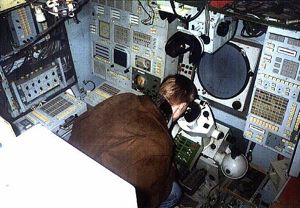
Home - Search - Browse - Alphabetic Index: 0- 1- 2- 3- 4- 5- 6- 7- 8- 9
A- B- C- D- E- F- G- H- I- J- K- L- M- N- O- P- Q- R- S- T- U- V- W- X- Y- Z
Soviet Conquest from Space
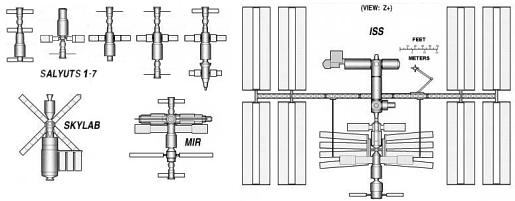
Space Stations
Comparison of flown space stations to a common scale and orientation.
Credit: Eric M Fischer
When it came to space stations, the Soviet Union started out with big ideas and then progressively reduced them. The N1 itself was originally designed around a conceptual space station not to be placed in near earth orbit but rather on a Mars flyby trajectory. This 1959 project of G U Maksimov's Section 3 of OKB-1 was called the 'Heavy Piloted Interplanetary Spacecraft (TMK).
It was planned that the N1 would put into orbit the spacecraft and its associated rocket stage, which would then launch the TMK on a ballistic trajectory past Mars. After the flyby of Mars the crew would intercept the earth, transferring to a return capsule for re-entry and landing on earth. TMK would have had a mass of 75 metric tons, length of 12 m, maximum diameter of 6 m, a crew of three, and a flight time of two to three years. The spacecraft included an instrument section, (in which was a radioactivity shelter for the crew in the event of solar flares) and a blue-green algae reactor to produce oxygen and food. During flight the TMK was revolved in order to generate artificial gravity for the crew.
Following an August 1962 meeting between Khrushchev and chief designers at Pitsunda, Khrushchev ordered the start of a project to put a 75 metric ton manned platform with nuclear weapons into low earth orbit. Korolev was authorized to proceed immediately with development of a three stage N1 launch vehicle with a 75 metric ton payload. Concurrently it is said that design and mock-up construction of this 'OS-1' orbital station began.
The official government decree of 24 September 1962 set forth the first of a series of impossibly optimistic schedules for development of the N1 launch vehicle. This foresaw completion of third stage tests by the end of 1964, first and second stages by mid-1965, completion of all engine test stand runs by the first quarter of 1965, completion of the launch complex by the end of 1964, and first launch in 1965.
The OS-1 itself evidently reached the mock-up stage. It is said that the mock-up was visible from the motorway that runs past the OKB-1 premises in Kaliningrad. However with the start of the moon landing project on 3 August 1964 the L3 lunar complex became the priority payload for the upgraded and redesigned N1. With the removal of Khrushchev from power, enthusiasm for the 'Battlestar Khrushchev' evidently waned. The military authorized development of the much more modest Almaz space station by Chelomei's OKB-52. First flight of the Almaz with a one year operational period was planned for 1968. This equivalent to the USAF Manned Orbiting Laboratory (MOL) project consisted of two components, the Almaz orbital station and the same-sized TKS ferry spacecraft. Both were to be equipped with 'Merkur' 3-man capsules.
By 1969 OKB-1 began development of an orbital station descended from OS-1. This would have had a mass of around 100 metric tons, to be launched by the N1 booster. The station was to be cylindrical, 6 m in diameter, 20 m long, with 4 docking ports for Soyuz spacecraft arranged at angles of 30 degrees to the longitudinal axis, looking like the feathers of an arrow.
Meanwhile, Chelomei's project was years behind schedule. The competing American MOL military space station was cancelled in July 1969. Although ten Almaz stations were claimed to be 'in advanced stage of completion' by the end of 1969, no flight tests had yet been undertaken of the new three man capsule. Having lost the moon race, but seeing a chance to beat the Americans in the space station race, Brezhnev ordered Mishin's OKB-1 to undertake a crash program to develop a 'civilian' space station using components from Chelomei's Almaz program. Mishin was given control over the Almaz production line at Chelomei's Khrunichev facility in order to build the DOS-7K civilian station using the Almaz spaceframe but proven Soyuz components. Under the revised plan both the DOS-7K and Almaz stations would use OKB-1's Soyuz spacecraft to ferry crews to orbit instead of the 3-man capsule of the TKS. With the beginning of work on the Salyut station the large, long term N1-launched station was cancelled.
In the second half of 1972 and first half of 1973, simultaneous with other work, TsKBEM began technical development of a Multi-module Orbital Complex (MOK). The MOK was designed to solve a wide range of tasks: astronomical and astrophysical research, materials research, navigation, communications , remote sensing for study of forestry, farming, geology, fisheries, etc., and military applications.
MOK was not a single spacecraft but an integrated collection of earth-based and near-earth orbital systems consisting of:
- Multi-module Cosmic Base Station (MKBS)
- Autonomous spacecraft, operating from the MKBS
- Transport systems, using at first expendable supply transport craft, to be replaced later by reusable systems
- Launch vehicle systems
- Launch sites
- Autonomous test systems
- Search and rescue complexes
The MKBS would control all of the linked orbital systems and provide base quarters for the crews, an orbital control center, a supply base, and servicing facilities for on-orbit systems. Independently functioning spacecraft would dock with MKBS for repair, upgrade, and refueling. The MKBS would co-ordinate all of the autonomous spacecraft's' activities and maneuvers, resulting in a unified transport system.
The MKBS consisted of two large core modules of 80 and 88 metric tons each, launched by the N1. These were powered by a 200 kW nuclear power plant derived from OKB-1's work on nuclear electric propulsion. Solar arrays totaling 140 square meters of area provided 14 kW of backup power. Two Proton-launched modules were connected to large arms which spun to provide artificial gravity for crew conditioning and experiments. Additional Soyuz and TKS-derived modules could be attached and detached to conduct special studies. Total mass of the station was to be up to 250 metric tons, with a basic core diameter of 6 m and a length of 100 m. The operational MKBS would be placed in a sun synchronous orbit of 400 to 450 km altitude at an inclination of 97.5 degrees. A basic crew of six, with a maximum of ten, would inhabit the station throughout its ten year life. Crews would serve two to three month tours, with overlapping crew member replacements four times a year. The station was to be equipped with a total of eight motor clusters consisting of orbital correction motors of 300 to 1,000 kgf, coarse orientation motors of 10 to 40 kgf, and ion engines for fine orientation and orbital altitude maintenance with a thrust of 100 to 300 grams.
The primary overall requirement was to define a MOK system which could perform a broad range of tasks while minimizing expenditures in the creation of the system and its subsequent use. These requirements were met by the following technical decisions:
- It was desirable to minimize the quantity, cost, and crew size of orbital spacecraft while not making any single spacecraft too complex. This was solved by always considering that a particular part of a task might better be accomplished by another spacecraft, rather than having a single spacecraft accomplish everything.
- Communications and earth surveillance requirements of the base MOK would best be met by a sun-synchronous orbit of 97.5 degrees inclination
- The active life of the MOK would be for 7 to 10 years utilizing continual replenishment of the spacecraft and in-flight repairs
- Consumption of fuel in moving from earth to orbit and from orbit to orbit would be reduced by having fuel dumps in a supporting orbit and using ion engines for spacecraft orientation
- Landing capsules would at first be used for imagery recovery, but digital downlink would be developed quickly to eliminate this consumable item
- A special modification of the existing Soyuz 7K with manipulators would be used for inter-orbital ferry and regular repair service of autonomous spacecraft while being based at the MKBS
- The development cost would be minimized by use of existing or in-development systems:
- Soyuz 7K-T spacecraft and Soyuz launch vehicle as the basic transport craft
- Development of unpiloted modifications of Soyuz for use as MKBS visiting modules
- Development of the basic modules from the existing Salyut space station 17K, launched by the Proton booster
- Use of the N1 for launch of the MKBS core spacecraft
- Use of the N1 with the Block Sr upper stage for delivery of special modules to geostationary orbit
- Maximum use of existing and in-development facilities for support of MOK, such as launch complexes, command and control centers, etc.
- Reduction of the cost of transportation to and within the system, by putting all future satellites as much as possible in the same orbital plane of 97.5 degrees, and by development of new economical reusable transport systems
- Soyuz 7K-T spacecraft and Soyuz launch vehicle as the basic transport craft
The development of the MOK would been undertaken in two phases: An experimental phase (near earth orbit around 51.5 degrees) and an operational phase (sun-synchronous orbit of 97.5 degrees). In May 1974 the N1 was cancelled, and with it, the MOK.
Technical development of the MOK was the first large-scale space technology study which used combined , earth resources studies, economic analysis to determine the best engineering solutions. Various technical results obtained in the process of this work were used for a long time after. In particular the development of the Progress replenishment spacecraft, Soyuz space station ferries, and special-purpose modules of the Mir spacecraft can be traced directly to the concepts and designs for the MOK. Leading participants in the project were I N Sadovskiy, V V Simakin, B E Chertok, V S Ovchinnikov,, M V Melnikov, A P Abramov, V D Vachnadze, V K Bezberbiy, A A Rzhanov, I E Yurasov, V Z Ilin, G A Dolgopolov, N P Bersenev, K B Ivanov, V C Anfyrev, B G Sypryn , V P Zaitsev, E A Shtarkov, I V Gordeev, B V Korolev, V G Osipov, V N Lakeyev, V P Byrdakov, A A Kochkin.
It is interesting to note that American propulsion engineer Peter James described the MOK in considerable and accurate detail in his 1974 book Soviet Conquest from Space. The book was dismissed by many authorities because the systems described in it never appeared. Only in the last two years has it become apparent that the system described to Mr James was in development, but was cancelled at just about the same time his book appeared.
Continuous elaboration of the Almaz and DOS-7K designs during the Almaz and Salyut programs of the 1970's and early 1980's gave the Soviet Union the pre-eminent lead in manned spaceflight. The ultimate expression of this evolutionary approach was the Mir space station of the 1980's and 1990's, which met many of the objectives of the MOK study. Russian elements of the International Space Station of the next century are still derived from the basic modules designed for Almaz and MOK in the 1960's.
Primary reference for this article is the official RKK Energia history of the N1 development as described in Raketno-Kosmicheskaya Korporatsiya ENERGIYA imeni S. P. Koroleva 1946-1996. The single exception is information concerning on the 1960's military OS-1 station, which is from Charles Vick's article in Spaceflight, Volume 36, Page 89.
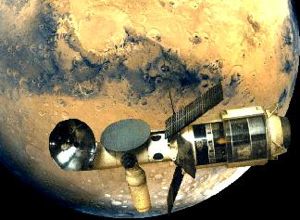 | TMK Mars flyby TMK Mars flyby spacecraft Credit: © Mark Wade |
 | TOS - 1969 TOS - N1 launched space station - 1969 Credit: © Mark Wade |
 | Salyut 6 Salyut 6 as displayed in Moscow in 1981. Credit: © Mark Wade |
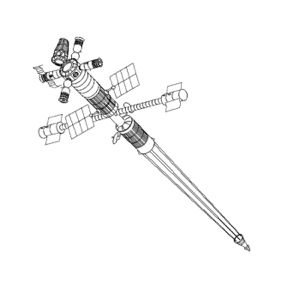 | MKBS Orbital Station MKBS Multi-module Orbital Base Station Credit: © Mark Wade |
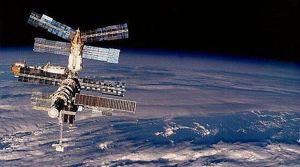 | Mir View of Mir in space. Credit: NASA |
Back to top of page
Home - Search - Browse - Alphabetic Index: 0- 1- 2- 3- 4- 5- 6- 7- 8- 9
A- B- C- D- E- F- G- H- I- J- K- L- M- N- O- P- Q- R- S- T- U- V- W- X- Y- Z
© 1997-2019 Mark Wade - Contact
© / Conditions for Use
